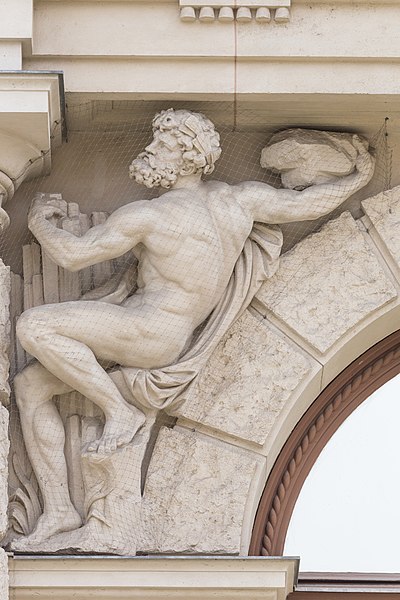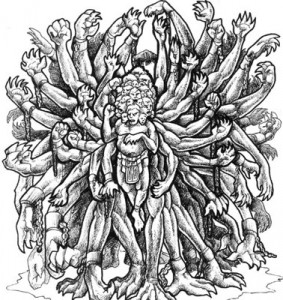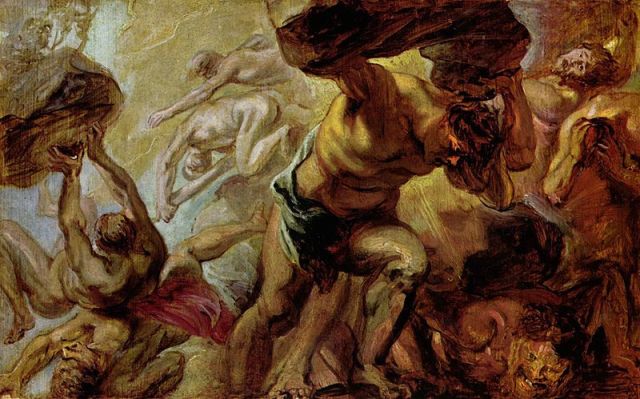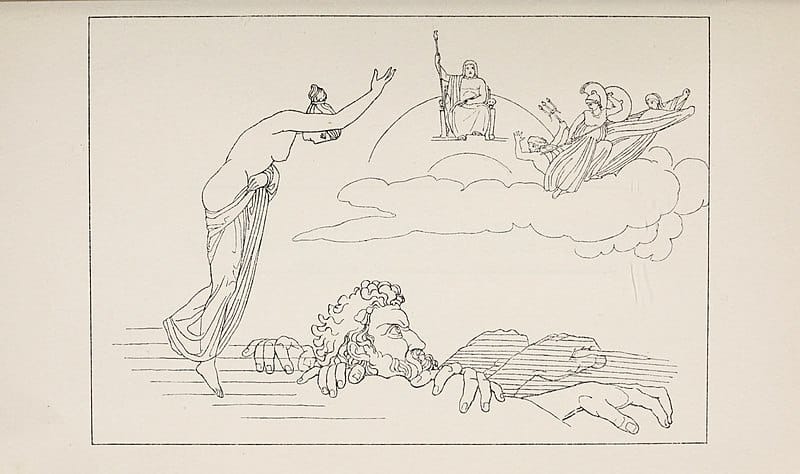When it comes to awe-inspiring monsters in Greek mythology, the Hecatoncheires are in a league of their own. These hundred-handed giants are as fascinating as they are terrifying, embodying the chaotic forces of nature itself. In this article, we’ll delve into the intricate tapestry of myths and facts that surround these enigmatic beings.
Hecatoncheires Key Facts
| Origin | Uranus and Gaia |
| Defeated by | None |
| Siblings | The Cyclopes and the first generation Titans |
| Habitat | Tartarus, later Olympus |
| Other names | Centimanes |
| Roman name | Centimani |
| Associated with | Chaos, Strength |
| Symbols | Hundred Hands, Fifty Heads |
Name and Etymology
The name “Hecatoncheires” is derived from the Greek words “hekaton,” meaning “hundred,” and “cheir,” meaning “hand.” It’s a name that’s as literal as it gets, describing their most distinctive feature—hundred hands. In Roman mythology, they are known as the Centimani, which also translates to “hundred-handed.”

The individual names of the Hecatoncheires are Cottus, Briareus, and Gyges. Each name carries its own significance, often related to their immense strength and fearsome nature. For instance, Briareus is also known as Aegaeon, which means “stormy one,” capturing his tumultuous essence.
While they are primarily known by their individual names and the collective term “Hecatoncheires,” they don’t have as many epithets as other figures in Greek mythology. However, they are sometimes referred to as the “Children of Gaia and Uranus,” emphasizing their divine origin.
Hecatoncheires Origin and Creation
The Hecatoncheires were born to Uranus and Gaia, the primordial sky and earth gods. They were the siblings of the Titans and the Cyclopes, making them part of the earliest generations of divine beings. However, their father Uranus was so horrified by their appearance that he imprisoned them in Tartarus, the deepest part of the underworld.
Their existence serves as a representation of the chaotic and untamed forces of nature. They were initially feared and shunned even by their own family, symbolizing the darker aspects of the world that even the gods wished to keep at bay.
Eventually, they were freed by Zeus during his war against the Titans. Grateful for their liberation, the Hecatonchires sided with Zeus and played a crucial role in overthrowing the Titans, thus shifting the cosmic balance of power.
Depiction And Characteristics
Let’s explore how these hundred-handed giants have been depicted and what sets them apart from other mythical beings.

The Hecatoncheires are most notably characterized by their hundred hands and fifty heads. This grotesque multitude of limbs and faces adds to their terrifying aura. They are often depicted as colossal beings, towering over gods and mortals alike, embodying the untamed forces they represent.
Their appearance serves as a visual metaphor for chaos and overwhelming strength. While they don’t have specific symbols associated with them, their very form—those numerous hands and heads—becomes a symbol of their unparalleled might and complexity.
Hecatoncheires Nature and Abilities
Despite their fearsome appearance, the Hecatonchires are not inherently evil. They are complex figures, embodying both the destructive and constructive forces of nature. After their release from Tartarus, they became allies of Zeus, guarding the gates of the underworld and maintaining cosmic order.
Their behavior in myths is often reactive rather than proactive. They respond to the actions of other gods, whether it’s being imprisoned by their father or aiding Zeus in his quest for supremacy. This somewhat passive role underscores their nature as forces to be harnessed or unleashed, rather than independent actors.
The Hecatoncheires are beings of immense strength and power. Each of their hundred hands could wield a boulder, making them formidable in battle. During the Titanomachy, the war between the Titans and the Olympians, they hurled rocks at such a rapid pace that the Titans were overwhelmed, tipping the scales in favor of Zeus and his allies.
Their abilities go beyond mere physical strength. They are also symbols of multiplicity and diversity, representing the many facets of nature’s power. Their complex nature makes them unpredictable, capable of both creation and destruction.
Hecatoncheires Symbols or Associations
The Hecatoncheires themselves are often considered symbols of chaos and untamed natural forces. Their hundred hands and fifty heads serve as visual representations of this chaotic nature, emphasizing their role as embodiments of the earth’s raw, untamed energy.
Another association is their role as guardians. After the defeat of the Titans, they were appointed as guards of Tartarus, holding the defeated Titans at bay. This role associates them with themes of justice and cosmic balance, adding another layer to their complex characterization.
Myths about Hecatoncheires
Let’s delve into the myths that feature these fascinating beings.
The Titanomachy: The War of the Gods

The most significant myth involving the Hecatoncheires is the Titanomachy. Imprisoned by their father, Uranus, and later by the Titan Cronus, they were finally freed by Zeus. Grateful for their liberation, they joined Zeus in his war against the Titans.
Their role in the war was pivotal. Armed with boulders, they unleashed a barrage against the Titans, overwhelming them and allowing Zeus to gain the upper hand. Their participation was crucial in shifting the balance of power in favor of the Olympians, leading to the establishment of Zeus as the king of the gods.
Guardians of Tartarus
After the defeat of the Titans, the Hecatoncheires were appointed as the guardians of Tartarus. Here, they ensured that the Titans could not escape, maintaining the new cosmic order established by Zeus. Their role as guardians highlights their transformation from feared outcasts to essential components of the divine order.
Representations In Art

The Hecatoncheires are not as commonly depicted in art as other figures from Greek mythology, likely due to their complex and grotesque form. However, when they do appear, it’s often in the context of the Titanomachy, emphasizing their role in the cosmic battle.
Their unique form poses a challenge for artists, making any representation of them a testament to the artist’s skill and imagination. They are usually portrayed in a way that emphasizes their overwhelming strength and chaotic nature, often in stark contrast to the more human-like forms of the gods.
Mentions in Ancient Texts
The Hecatoncheires are prominently featured in Hesiod’s “Theogony,” an epic poem that serves as one of the foundational texts of Greek mythology. Hesiod, a Greek poet believed to have lived around the 8th century BCE in Boeotia, provides a comprehensive genealogy of the gods and cosmic entities. His work is one of the earliest and most significant sources of Greek myth, and it offers a detailed account of the birth, imprisonment, and eventual liberation of the Hecatonchires.
Another text that mentions these hundred-handed giants is the “Bibliotheca,”. Traditionally attributed to Apollodorus of Athens, a scholar and historian from the 2nd century BCE, it was likely written by someone else around 1st century AD. This work is more of a mythological encyclopedia, summarizing various myths and legends. Apollodorus also discusses the role of the Hecatonchires in the Titanomachy, corroborating and expanding upon Hesiod’s account.
A quote from Hesiod’s “Theogony” encapsulates the awe-inspiring nature of these beings: “From their shoulders sprang a hundred arms, not to be approached, and each had fifty heads upon his shoulders, on their strong limbs.” This line not only emphasizes their physical attributes but also hints at the sense of dread and awe they inspired.
Frequently Asked Questions
There are three Hecatoncheires: Cottus, Briareus, and Gyges.
Their most distinctive features are their hundred hands and fifty heads, symbolizing their immense strength and chaotic nature.
They were initially imprisoned by their father, Uranus, and later by the Titan Cronus.
They allied with Zeus during the Titanomachy after he freed them from their imprisonment.
They are most famous for their role in the Titanomachy, where they helped Zeus defeat the Titans.
They are neither; they embody the chaotic and untamed forces of nature, capable of both destruction and order.
Featured Image Credit: Peter Paul Rubens, Public domain, via Wikimedia Commons
